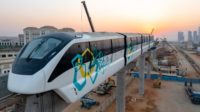Ship access capacity to the Antwerp’s Waasland Canal complex in Belgium will be more than doubled by construction of the world’s largest ship lock at the Deurganck dock. With a construction cost of some $290 million, the lock on the tidal River Scheldt’s left bank—500 meters long, 68 m wide and 17.8 m deep—is due to start operations in spring 2016.
The new lock will be more than 4 m deeper than the current world-record holder, Antwerp’s 25-year-old Berendrecht Lock, which serves docks on the opposite riverbank. It is also longer and wider than the new locks under construction for the third lane of the Panama Canal, but those locks will be up to 18.3 m deep. The Deurganck Lock will be the largest in the world by volume.
Rising some 20 m, the walls thicken to 5.5 m at the base, where the slab deepens to 5 m. The lock floor will slope down gently inland, directing silt to be trapped by a series of curved walls and diverted along conduits back to river. The Deurganck’s immense walls and slabs will consume nearly 800,000 cu m of concrete and 55,000 tonnes of rebar. To keep over 9 million cu m of excavation dry, the site is surrounded by a 2.7-kilometer slurry trench wall, keyed into underlying clay.
With the concrete casting well advanced since work started just over three years ago, the lock is due for flooding next April, says Freddy Aerts, the Flanders regional government’s head of maritime access. Because of earlier dredging delays, "the timing is tight" but within schedule, he adds. He reports "no big problems" on the 53-month job, which remains within budget, although it's eating into contingencies, he concedes.
The new lock is being built at the inland end of the 2.5-km Deurganck Dock, which is open to river tides. When complete, the lock will provide access through the dock to the inland Waasland canal dock complex, built in the 1970s. Now, access for large vessels to the Waasland system is through the 360-m x 50-m x 12.6-m Kallo lock, farther downstream. Already experiencing nearly 9,000 operations a year, the Kallo lock is a serious bottleneck, according a port authority spokeswoman.
The port authority and the Flanders government joined forces to procure the lock, contributing 74% and 26%, respectively, of the budget, which totals some $500 million, including associated buildings and infrastructure. They created the joint project company Deurganckdoksluis N.V., which raised some $297 million in loans from the European Investment Bank and the local KBC bank. The company also secured a $12.4-million European Union grant and provided the remaining financing from the port and Flanders government, explains Aerts.
Aerts is pleased to say that the lock design was handled by in-house teams. The port authority and the Flanders government have world-class expertise that has found international outlets, including on the Panama Canal expansion and the potential Nicaragua waterway, he says. Aerts is keen to retain that expertise. Outsourcing engineering design, as government agencies elsewhere in Europe have done, would pose "a big risk" to the port's well-being, believes Aerts.
To get the lock built, Deurganckdoksluis N.V. in September 2011 awarded a construction contract to the THV Waasland joint venture of Belgium’s Jan De Nul N.V., Hofstade-Aalst, and subsidiaries of Netherlands-based BAM Group, Amsterdam, and Eiffage Group, Paris, France. The three groups each own a third of the joint venture.
Among the hundreds of workers deployed, dozens are employed by a Romanian subcontractor supplying ironworkers to assemble the rebar cages, says a port spokesman. Another prominent subcontract, for the huge lock gates and road-rail bascule bridges over its entrances, went to the Chinese fabricator Shanghai Zhenhua Heavy Industry Co. Ltd. (ZPMC) in October 2011.
The subcontract covers four rolling steel box gates, which will be housed in large recesses at the lock’s two openings. Only one gate at each end will operate at any one time, while the other is on standby. Around 9,000 tonnes of steel will go into the gates and another 11,000 tonnes into the bridges, says a port spokesman.
With thousands of people at the ZPMC plant working on numerous international projects, maintaining quality is a challenge, says Aerts. The owner has four engineers at the plant, monitoring work. "To maintain quality, you have to push every day … never give up," Aerts observes.
Next April, the lock is due for flooding with water pumped from nearby reservoirs, says Aerts. Then, a few weeks later, the gates and bridges will arrive on-site to be floated into place, leaving less than under a year to complete all the installations.








.jpg?height=200&t=1654624305&width=200)

